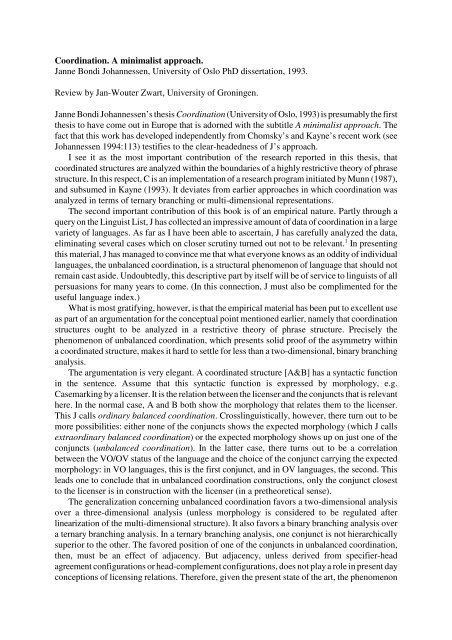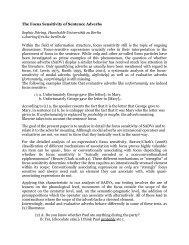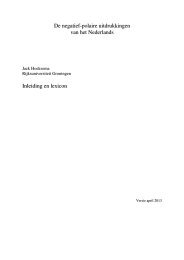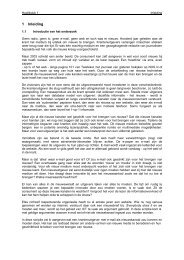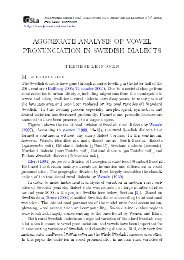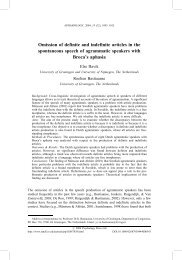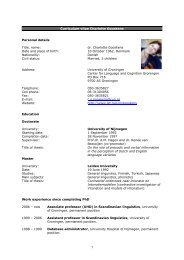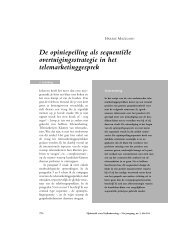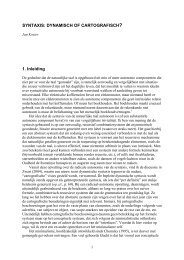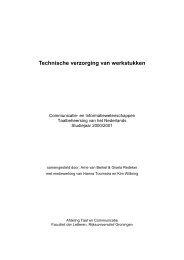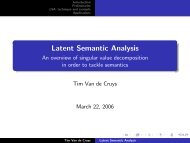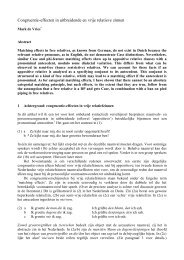Coordination. A minimalist approach. Janne Bondi Johannessen ...
Coordination. A minimalist approach. Janne Bondi Johannessen ...
Coordination. A minimalist approach. Janne Bondi Johannessen ...
Create successful ePaper yourself
Turn your PDF publications into a flip-book with our unique Google optimized e-Paper software.
<strong>Coordination</strong>. A <strong>minimalist</strong> <strong>approach</strong>.<br />
<strong>Janne</strong> <strong>Bondi</strong> <strong>Johannessen</strong>, University of Oslo PhD dissertation, 1993.<br />
Review by Jan-Wouter Zwart, University of Groningen.<br />
<strong>Janne</strong> <strong>Bondi</strong> <strong>Johannessen</strong>’s thesis <strong>Coordination</strong> (University of Oslo, 1993) is presumably the first<br />
thesis to have come out in Europe that is adorned with the subtitle A <strong>minimalist</strong> <strong>approach</strong>. The<br />
fact that this work has developed independently from Chomsky’s and Kayne’s recent work (see<br />
<strong>Johannessen</strong> 1994:113) testifies to the clear-headedness of J’s <strong>approach</strong>.<br />
I see it as the most important contribution of the research reported in this thesis, that<br />
coordinated structures are analyzed within the boundaries of a highly restrictive theory of phrase<br />
structure. In this respect, C is an implementation of a research program initiated by Munn (1987),<br />
and subsumed in Kayne (1993). It deviates from earlier <strong>approach</strong>es in which coordination was<br />
analyzed in terms of ternary branching or multi-dimensional representations.<br />
The second important contribution of this book is of an empirical nature. Partly through a<br />
query on the Linguist List, J has collected an impressive amount of data of coordination in a large<br />
variety of languages. As far as I have been able to ascertain, J has carefully analyzed the data,<br />
eliminating several cases which on closer scrutiny turned out not to be relevant. 1 In presenting<br />
this material, J has managed to convince me that what everyone knows as an oddity of individual<br />
languages, the unbalanced coordination, is a structural phenomenon of language that should not<br />
remain cast aside. Undoubtedly, this descriptive part by itself will be of service to linguists of all<br />
persuasions for many years to come. (In this connection, J must also be complimented for the<br />
useful language index.)<br />
What is most gratifying, however, is that the empirical material has been put to excellent use<br />
as part of an argumentation for the conceptual point mentioned earlier, namely that coordination<br />
structures ought to be analyzed in a restrictive theory of phrase structure. Precisely the<br />
phenomenon of unbalanced coordination, which presents solid proof of the asymmetry within<br />
a coordinated structure, makes it hard to settle for less than a two-dimensional, binary branching<br />
analysis.<br />
The argumentation is very elegant. A coordinated structure [A&B] has a syntactic function<br />
in the sentence. Assume that this syntactic function is expressed by morphology, e.g.<br />
Casemarking by a licenser. It is the relation between the licenser and the conjuncts that is relevant<br />
here. In the normal case, A and B both show the morphology that relates them to the licenser.<br />
This J calls ordinary balanced coordination. Crosslinguistically, however, there turn out to be<br />
more possibilities: either none of the conjuncts shows the expected morphology (which J calls<br />
extraordinary balanced coordination) or the expected morphology shows up on just one of the<br />
conjuncts (unbalanced coordination). In the latter case, there turns out to be a correlation<br />
between the VO/OV status of the language and the choice of the conjunct carrying the expected<br />
morphology: in VO languages, this is the first conjunct, and in OV languages, the second. This<br />
leads one to conclude that in unbalanced coordination constructions, only the conjunct closest<br />
to the licenser is in construction with the licenser (in a pretheoretical sense).<br />
The generalization concerning unbalanced coordination favors a two-dimensional analysis<br />
over a three-dimensional analysis (unless morphology is considered to be regulated after<br />
linearization of the multi-dimensional structure). It also favors a binary branching analysis over<br />
a ternary branching analysis. In a ternary branching analysis, one conjunct is not hierarchically<br />
superior to the other. The favored position of one of the conjuncts in unbalanced coordination,<br />
then, must be an effect of adjacency. But adjacency, unless derived from specifier-head<br />
agreement configurations or head-complement configurations, does not play a role in present day<br />
conceptions of licensing relations. Therefore, given the present state of the art, the phenomenon
of unbalanced coordination can only be analyzed in terms of hierarchic, binary branching, twodimensional<br />
structures.<br />
Assuming that licensing relations involve specifier-head configurations, and accepting the<br />
possibility of features percolating up or down the main projection line, unbalanced coordination<br />
is not at all an unexpected phenomenon. 2 If [A&B] occupies the specifier position of a projection<br />
headed by some licenser C, and & is the head, and A the specifier, of [A&B] (more properly<br />
represented as [A[&B]]), we expect A to be licensed by C via spec-head agreement of A and &<br />
and spec-head agreement of the projection of &, [A&B], and C. Crucially, what we do not expect<br />
is for B to be in construction with C in the same way as A is. As J shows, B typically receives<br />
default morphology in unbalanced coordination constructions.<br />
From the same perspective, extraordinary balanced coordination, in which both A and B<br />
show default morphology, can be described if we assume that something goes wrong in this<br />
‘transitive’ licensing process, in which A agrees with C because A agrees with &, the projection<br />
of which agrees with C. J (p. 92) assumes that in this type of constructions, [A&B] itself cannot<br />
enter into the relevant licensing relation, which somehow sounds less plausible to me. Stahlke’s<br />
(1984:360) example Them and us are going to the game together (quoted on p. 58) shows that<br />
there is agreement between the coordinated construction and the head licensing number<br />
agreement. This makes it hard to maintain that [A&B] is not in construction with a functional<br />
head (or, in <strong>minimalist</strong> terms, is not involved in checking N-features). Rather, it seems the case<br />
that the individual members A and B are not assigned Case, perhaps because of a failure of<br />
percolation of the relevant features. But these are technicalities. The point remains that the<br />
structure assumed by J makes it easy to account for what have appeared to be weird phenomena<br />
for a long time.<br />
J presents her case so convincingly that it becomes hard to understand how ordinary balanced<br />
coordination (in which both A and B are in construction with C) can be a phenomenon of<br />
language at all. J’s account of ordinary balanced coordination is less satisfactory (p. 94f).<br />
Basically, J considers it to be a lexical feature of the conjunction that the features of A are<br />
required to be on B as well. This is little more than a rephrasing of the phenomenon. A more<br />
interesting <strong>approach</strong> might have capitalized on the possibility of there being actually two<br />
conjunctions in a simple coordinated construction, as in (1).<br />
(1) [ A & [ B & ]] (order irrelevant)<br />
Agreement between A and B (and with the licenser C outside the coordinated construction) can<br />
then be analyzed as being parasitic on the head-head agreement of the two conjunctions.<br />
Multiple coordination, as in (1), is a familiar phenomenon from languages like Latin and<br />
Greek. Although I know of no languages where multiple coordination is actually obligatory, the<br />
wide spreadedness of the phenomenon might be taken to suggest that coordinations actually<br />
contain as many conjunctions as conjuncts. This possibility is not explored in the thesis.<br />
J briefly discusses ‘discontinuous conjunctions’ of the type both A and B (p. 105). She shows<br />
that the both element in this type of construction has a funny status, as it may be moved away<br />
from the A and B part. This, however, does not in principle argue against an analysis in which<br />
both originates as a head within the coordinated construction (as is also argued by Kayne 1994).<br />
Still, both adds a distributive reading to A and B, which suggests that it should be treated<br />
separatedly from an ordinary A and B construction, which might originate as a complement to<br />
the distributive head both.<br />
It would be interesting to study multiple conjunction on a larger scale. If ordinary balanced<br />
coordination is a matter of concatenation of spec-head agreement and head-head agreement, all<br />
coordinated constructions might show multiple coordination (and the Latin type coordination
must be regarded as prototypical). This would lead one to believe that the complement of both<br />
is in fact something like (1). This predicts that not all multiple conjunction structures in the<br />
world’s languages have a distributive reading, something worth looking into.<br />
Multiple conjunction phenomena have led Grootveld (1993) to conclude that the proper<br />
representation of coordination involves multiple dimensions. But if we assume that there is a<br />
conjunction for each conjunct, no such conclusion is warranted. Consider the following facts<br />
from Dutch.<br />
(2) a. en A en B en C kochten een auto<br />
and A and B and C bought a car<br />
b. en A en en B en C kochten een auto<br />
and A and and B and C bought a car<br />
(2a) has at least two interpretations: one in which A, B, and C each individually buy a car, and<br />
one in which (for instance) B and C together buy a single car. In the first case, we end up with<br />
three cars being sold, in the second case, with two. In other words, B and C form a group in the<br />
second reading of (2a), something we wish to represent in the X-bar structure of en A en B en C.<br />
A plausible binary branching structure of (2a) is (3) (the structure in (3) abstracts away from<br />
the surface ordering of the elements involved, in which the agreement relations would be more<br />
properly expressed):<br />
(3) &P1<br />
&P<br />
&1 &P2<br />
A &P<br />
&2 &P3<br />
B &P<br />
&3 C<br />
How can we read the different readings of (2a) off of the structure in (3)? &P3 is a complement<br />
of &2. The two readings of (2a) can now be formulated as follows: &P3 is transparent in the<br />
distributive reading of (2a), in which we end up with three cars being sold, and &P3 is opaque<br />
in the group reading of (2a), leading to only two cars being sold. However, the structure in (3)<br />
does not allow us to derive this difference, since the relation between &2 and &P3 is the same<br />
in both cases.<br />
I believe that the construction in (2b) provides the clue to the solution of this problem. The<br />
interpretation of (2b) is that B and C constitute a group of which each member individually buys<br />
a car. For some reason, which does not concern us here, the group B and C is set apart from A<br />
(perhaps indicating that there have been only two buying events), just like in the group reading<br />
of (2a). But unlike the group reading of (2a), and like the distributive reading of (2a), we end up<br />
with three cars being sold. Let us call the reading of (2b) a ‘layered distributive’ reading.<br />
Structurally, the second en conjunction from the left in (2b) takes the group en B en C as its<br />
complement. There is, then, a one-to-one correspondence between the number of conjuncts and<br />
the number of conjunctions. This leads to a structural representation like (4):
(4) &P1<br />
&P<br />
&1 &P2<br />
A &P<br />
&2 &P1'<br />
&P<br />
&1' &P2'<br />
B &P<br />
&2' C<br />
In (4), &P1' is the second conjunct of the root coordinated structure, just like &P3 in (3), but<br />
&P1' itself is a coordinated structure, unlike &P3 in (3).<br />
If (4) is a correct representation of the group character of (en) B en C in (2b), the group<br />
reading of (2a) should be represented in the same way. This implies that (2a) is actually<br />
structurally ambiguous between (3) and (4), the distributive reading corresponding to (3), and the<br />
group reading corresponding to (4).<br />
If this is correct, we are led to two conclusions. First, the difference in interpretation between<br />
the group reading of (2a) and the layered distributive (2b) is not a matter of structure. In both<br />
cases (en) B en C is structurally represented as a group. This contrasts the group reading of (2a)<br />
and the layered distributive (2b) on the one hand with the distributive reading of (2a) on the<br />
other. Consequently, the difference between the group reading of (2a) and the layered distributive<br />
(2b) must be expressed in terms of the nature of the conjunction &1' (cf. (4)). In the layered<br />
distributive (2b), this must be a distributive conjunction, comparable to English both. In the<br />
group reading of (2a), &1' must be a non-distributive conjunction, which remains empty in Dutch<br />
and English.<br />
The second conclusion is, that since this empty conjunction is needed to express the nondistributive<br />
group interpretation of B en C in (2a) (i.e., &P1' in (4)), simple non-distributive<br />
conjunctions like A and B must involve an empty non-distributive conjunction as well. Hence,<br />
A and B, in the non-distributive reading, is more properly represented as i A and B.<br />
This supports the idea that the number of conjunctions always equals the number of<br />
conjuncts. On this analysis, ordinary balanced coordination can simply be analyzed as involving<br />
an additional step, namely head-head agreement between the two conjunctions.<br />
The proper analysis of agreement within the coordination phrase presumably requires the<br />
adoption of functional projections inside the coordination phrase, allowing conjunctions and<br />
conjuncts to move in order to generate word order variation. As the structures in (3) and (4)<br />
stand, the rightmost conjunct cannot agree with the rightmost conjunction, since conjunct and<br />
conjunction are in a head-complement relation. This aspect has been ignored in the discussion<br />
above.<br />
Word order variation within coordinated constructions is also a topic which J’s thesis clearly<br />
puts on the research agenda. The generalization that the position of the agreeing conjunct in<br />
unbalanced coordination correlates with the position of the head in the general phrase structure<br />
schema looks extremely strong. Of the 6 potential counterexamples, Afrikaans, Dutch, Estonian,<br />
German, Homeric Greek, and Vedic, 3 are Germanic OV languages which have recently been
eanalyzed as VO languages (Zwart 1992). This clearly strengthens the typological<br />
generalizations made in J’s book.<br />
It would have been interesting to see a discussion of the word order variation in coordination,<br />
and of the variation regarding which of the conjuncts is the regular one in unbalanced<br />
coordination, in the context of Kayne’s (1993) conjecture that heads and specifiers are invariably<br />
to the left. J crucially relies on the reality of a basic OV/VO distinction in her analysis of<br />
unbalanced coordination. Thus, in an OV-language, it is the second conjunct which is in<br />
construction with the licenser outside the coordinated construction. To account for this, J<br />
assumes that the relevant languages have a specifier position to the right, occupied by the second<br />
conjunct, which then agrees with the outside head, also positioned to the right.<br />
If Kayne is right, the OV order must be derived by movement, and so must the order of the<br />
conjuncts within the coordinated construction. It is not immediately clear how this can be worked<br />
out, which makes it understandable, though regrettable, that J refrained from tackling this<br />
question.<br />
J’s laudable preoccupation with issues of phrase structure extends to the rather tricky question<br />
of how coordinate structures come into being (in a phrase structural sense). It seems to me that<br />
here J’s <strong>approach</strong> is not as compatible with the <strong>approach</strong> to phrase structure building in Chomsky<br />
(1992) as we are led to believe.<br />
First off, simple coordinations like A and B can easily be derived in the bottom-up structure<br />
building procedure of Chomsky (1992). Insertion of such a chunk in a larger structure, for<br />
instance in the complement position of a verb, is a possibility that the structure building<br />
procedure does not exclude (contrary to what J suggests on p. 129). The question that arises,<br />
however, is whether all coordination phenomena can be described in terms of this bottom-up<br />
structure building process.<br />
J argues that coordination always involves two or more CPs (see also Van Oirsouw 1987,<br />
Wilder 1994). Of the elements of these component sentences, those that match are merged, and<br />
those that do not match are coordinated (by a process called coordinate alpha). 3 Van Oirsouw<br />
and Wilder, on the other hand, assume that matching elements delete. The merging <strong>approach</strong> and<br />
the deletion <strong>approach</strong> may be viewed as two opposing trends in theorizing about coordination.<br />
In opting for merging, J essentially sides with the factorization <strong>approach</strong> of Williams (1978) and<br />
the linearization <strong>approach</strong> of Goodall (1987).<br />
It is unfortunate that the thesis does not contain an extensive discussion of the merging<br />
<strong>approach</strong> as compared with the deletion <strong>approach</strong> (see e.g. p. 113). Merging and coordinate alpha<br />
cannot but be viewed as additions to the structure building process of generalized transformation,<br />
whereas deletion merely makes use of zero copies of material elsewhere expressed.<br />
There is much more that could be said about this thesis. For example, J’s claim that<br />
extraction from coordinated constructions is constrained on grammatical rather than syntactic<br />
grounds (p. 133), does not seem to be supported by an adequate analysis of the relevant data.<br />
Since anything can be coordinated with anything in the coordinate alpha <strong>approach</strong>, there is no<br />
reason to analyze the conjunction reduction facts studied in H`hle (1983), Zwart (1991), and<br />
elsewhere as involving extraction out of the first conjunct (see p. 137). 4<br />
In all, however, the exploratory nature of much of the analysis is counterbalanced by the<br />
wealth of new material for the linguistic community to think about.<br />
Footnotes<br />
1. This is not to say that J’s analysis of the data is beyond discussion. For instance, she consistently analyzes serial<br />
verb constructions as involving coordination rather than subordination (p. 33). I also disagree with the judgment
that Dutch ik heb zij die elders wonen voor ogen ‘I am referring to they who live elsewhere’ is less grammatical than<br />
when this sentence would be the second conjunct of a coordinated construction (p. 10). Significantly worse,<br />
however, is Ik heb niet alleen de Kroaten voor ogen maar ook zij ‘I am not only referring to the Croats but also they<br />
(i.e. to them)’. Also, (56b) on p. 100, which should include a conjunction en in front of the second conjunct, must<br />
be considered grammatical, rather than marginal. I’m not sure that additional cross checking would have eliminated<br />
the discrepancies, however. For many languages, cross checking was probably not even a possibility within the<br />
limits of the research project leading to this thesis.<br />
2. Percolation appears to have been introduced in grammatical terminology by Dougherty (1968), as part of an<br />
analysis of coordination.<br />
3. ‘Merging’ in this sense should not be confused with ‘merging’ in the sense of Chomsky 1994, in which it is used<br />
as a different term for ‘generalized transformation’.<br />
4. J’s analysis of these constructions on p. 118, illustrating the merge operation, also ignores the possibility of<br />
coordinating unlike categories.<br />
References<br />
Chomsky, N. (1992) ‘A Minimalist Program for Linguistic Theory’. MIT Occasional Papers in<br />
Linguistics 1.<br />
Chomsky, N. (1994) ‘Bare Phrase Structure’. MIT Occasional Papers in Linguistics 5.<br />
Dougherty, R.S. (1968) A Transformational Analysis of Coordinate Conjoined Structures.<br />
Unpublished MIT dissertation.<br />
Goodall, G. (1987) Parallel Structures in Syntax. <strong>Coordination</strong>, Causatives and Restructuring.<br />
Cambridge: Cambridge University Press.<br />
Grootveld, M. (1993) ‘An underspecified <strong>approach</strong> to parsing coordination’. Paper presented at<br />
the University of Groningen.<br />
H`hle, T. (1983) ‘Subjektslhcken in Koordinationen’. Ms., University of Cologne.<br />
<strong>Johannessen</strong>, J.B. (1994) ‘Coordinate-Alpha’. In Console 1 Proceedings, P. Ackema and M.<br />
Schoorlemmer, eds., The Hague: Holland Academic Graphics, 99-114.<br />
Kayne, R.S. (1994) ‘<strong>Coordination</strong>’. University of Groningen guest lecture, October 3.<br />
Kayne, R.S. (1993) ‘The Antisymmetry of Syntax’. To appear Cambridge: MIT Press.<br />
Munn, A. (1987) ‘Coordinate Structure and X-bar Theory’. McGill Working Papers in<br />
Linguistics 4.<br />
Oirsouw, R.R. van (1987) The Syntax of <strong>Coordination</strong>. London: Croom Helm.<br />
Stahlke, H. (1984) ‘Independent and clitic pronouns in English’. In Papers from the Chicago<br />
Linguistic Society, Chicago, 358-364.<br />
Wilder, Chr. (1994) ‘<strong>Coordination</strong>, ATB, and Ellipsis’. In Minimalism and Kayne’s Asymmetry<br />
Hypothesis., C.J.W. Zwart, ed., Groninger Arbeiten zur germanistischen Linguistik,<br />
University of Groningen, 291-329.<br />
Williams, E.S. (1978) ‘Across The Board Rule Application’. Linguistic Inquiry 9, 31-43.<br />
Zwart, C.J.W. (1991) ‘Subject Deletion in Dutch: a difference between Subjects and Topics’. In<br />
Language and Cognition 1, M. Kas, E. Reuland, and C. Vet, eds., University of Groningen,<br />
333-349.<br />
Zwart, C.J.W. (1992) ‘SOV Languages are Head Initial’. Paper presented at the 8th Comparative<br />
Germanic Syntax Workshop, Tromsr, November 21. To appear in The Linguistic Review as<br />
‘Dutch is Head Initial’.


